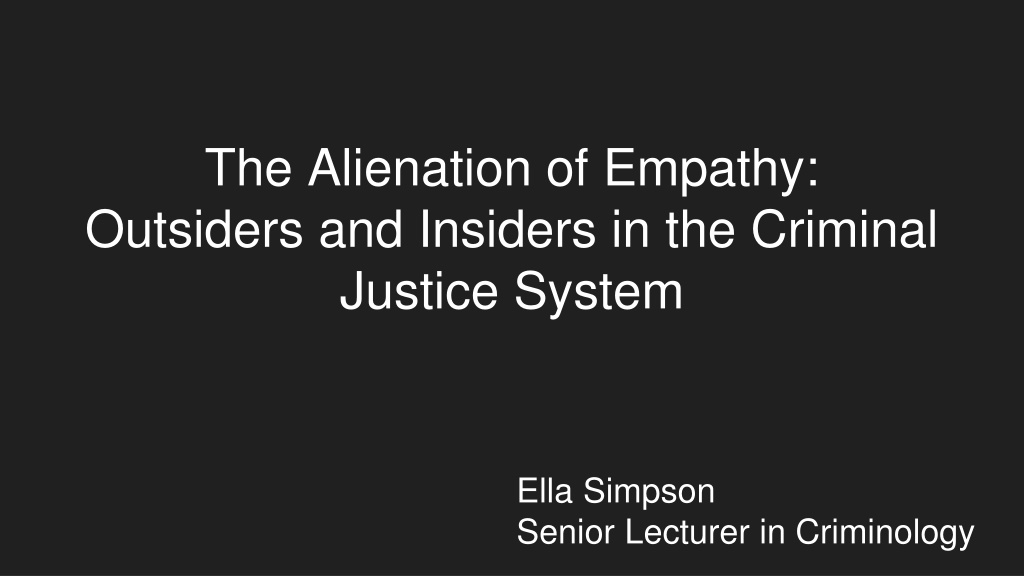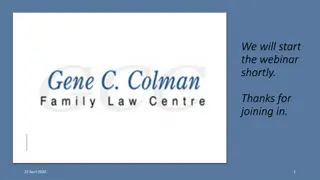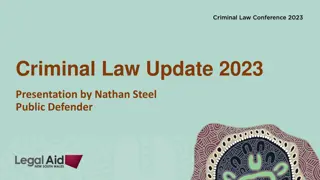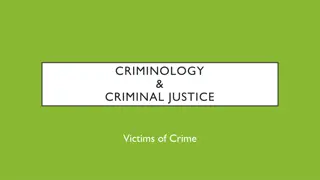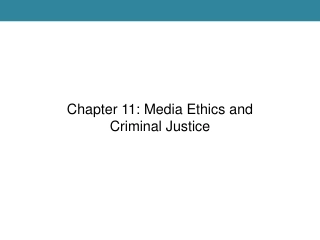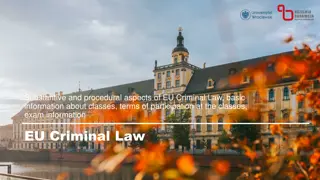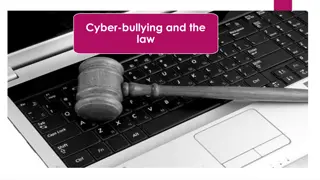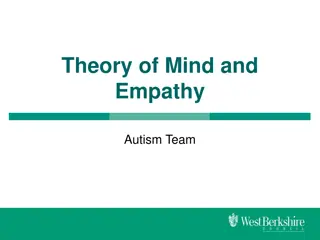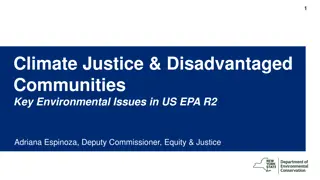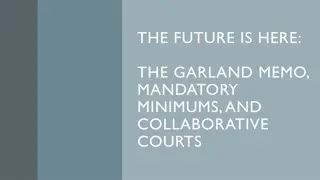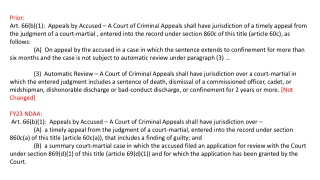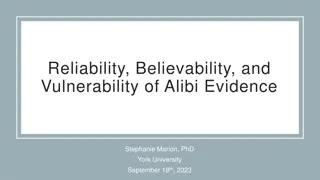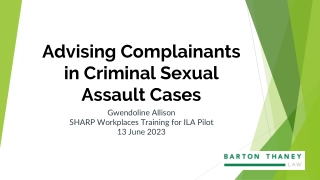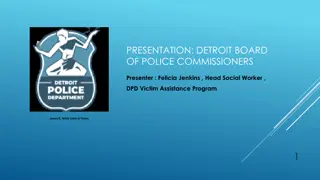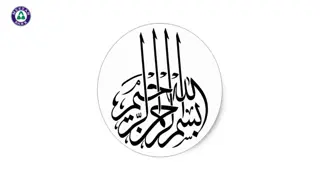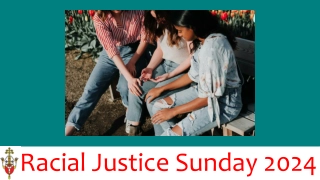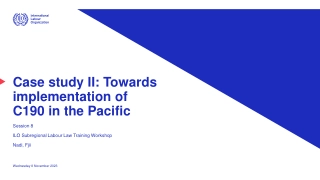The Alienation of Empathy: Outsiders and Insiders in Criminal Justice
Explore the concepts of empathy, sympathy, and alienation in the criminal justice system through the lens of insiders and outsiders. Delve into the distinctions between sympathy and empathy, the historical perspective on justice, pre-modern punitive practices, and the role of mercy in rural aristocracy. Understand how these dynamics shape perceptions and interactions within the legal landscape.
The Alienation of Empathy: Outsiders and Insiders in Criminal Justice
PowerPoint presentation about 'The Alienation of Empathy: Outsiders and Insiders in Criminal Justice'. This presentation describes the topic on Explore the concepts of empathy, sympathy, and alienation in the criminal justice system through the lens of insiders and outsiders. Delve into the distinctions between sympathy and empathy, the historical perspective on justice, pre-modern punitive practices, and the role of mercy in rural aristocracy. Understand how these dynamics shape perceptions and interactions within the legal landscape.. Download this presentation absolutely free.
Presentation Transcript
The Alienation of Empathy: Outsiders and Insiders in the Criminal Justice System Ella Simpson Senior Lecturer in Criminology
The Alienation of Empathy Sympathy and empathy: Some important distinctions Sympathy and empathy in criminal justice The role of charity Alienation: The prisoner s view Alienation: The practitioners view
Sympathy and Empathy part of the definitional confusion regarding empathy results from the fact that theorists and researchers, while all studying "empathy," are in fact frequently addressing quite different parts of a larger phenomenon (Davis, 2018: 11) Sympathy is a special kind of empathy (Chismar, 1988: 258) Einfuhlung...was developed in late-nineteenth-century Germany...to describe an embodied response to an image, object, or spatial environment (Voss, 2006: 139)
Sympathy and Empathy sympathy refers to the heightened awareness of another's plight as something to be alleviated. Empathy refers to the attempt of one self-aware self to understand the subjective experiences of another self. Sympathy is a way of relating. Empathy is a way of knowing. (Wispe, 1986: 314)
Pre-Modern Justice The body as the major target of penal repression (Foucault, 1977: 8)
Punishment of the Body Damiens was taken... to the Place de Greve, where, on a scaffold... the flesh will be torn from his breasts, arms, thighs and calves with red-hot pincers, his right hand, holding the knife with which he committed the said parricide, burnt with sulphur, and, on those places where the flesh will be torn away, poured molten lead, boiling oil, burning resin, wax and sulphur melted together and then his body drawn and quartered by four horses and his limbs and body consumed by fire (Foucault, 1977: 3)
Mercy The rural aristocracy... used their prerogative of clemency and leniency (Hopkins-Burke, 2009: 3)
The Bloody Code Hanging was the standard form of execution and was the typical punishment for offences ranging from murder to stealing turnips, writing threatening letters or impersonating an outpatient of Greenwich Hospital (Radzinowicz, 1948 cited in Hopkins-Burke, 2009: 3)
The Reformist Narrative powered by revulsion at physical cruelty, by a new conception of social obligation to the confined, and by impatience with the administrative inefficiency manifested in the squalid neglect of prisoners. (Ignatieff, 1981: 154) the heightened awareness of another's plight as something to be alleviated. (Wispe, 1986:314)
The Penal Reformers The modern prison was the result of efforts by philanthropic and administrative reformers (Ignatieff, 1981: 162) John Howard (1726-1790) Elizabeth Fry (1780-1845)
Prison Conditions Howard's emphasis was on the physical conditions of prisons... he was far more concerned with the preservation of health (Cooper, 1976: 75)
The Condition of Prisoners two members visited Newgate daily: the Scriptures were read; the prisoners were employed at sewing, spinning, and knitting, the profits of their labor returning to them; and a school was established for the prisoners and their children so that they might learn to read the Bible (Cooper, 1981: 683)
Creative Conditions?... the women persuaded her to provide them with needlework (Rogers, 2013: 10) The quilt was intended to travel back to Britain as a gift, documenting the safe passage of... the female convicts (Smith, 2008)
...or Creative Conditioning? treating the history (of prisons) as a progress from cruelty to enlightenment. (Ignatieff, 1981: 154) the roots of the British CSOs are located in charity distributed by the elite and middle classes to the poor (Taylor 2004; Kendall and Knapp 1996) (Helminen, 2015: 75)
The Revisionist Narrative The philanthropic campaigns to reform old institutions and to build new...prisons... gave expression to a new strategy of class relations. In return for the humanity of minimal institutional provision, the disobedient poor were drawn into a circle of asceticism, industriousness, and obedience. They would return to society convinced of the moral legitimacy of their rulers. The persistent ideal of prison reform was a kind of punishment at once so humane and so just that it would convince the offender of the moral legitimacy of the law and its custodians...Personal reformation thus meant succumbing to the benevolent logic of their captors. (Ignatieff, 1981: 169-170)
(Lack of) Empathy in Prison (There is) a relative neglect of empathy in explanations of crime and delinquency (Posick et al., 2015: 575) The publication of Cleckley s text, The Mask of Sanity (1941), marked the beginning of the modern clinical construct of psychopathy (Arrigo & Shipley, 2001: 334)
Psychopathy primary psychopathic characteristics of glibness, superficial charm, emotional detachment, and lack of remorse or guilt (Arrigo & Shipley, 2001: 335) psychopaths are... short-tempered, unable to form strong emotional bonds with others, and (are) lacking in empathy, guilt or remorse (Hart & Hare, 1997: 22-23)
Reformation to Rehabilitation "It is impossible to dissociate language from science or science from language...to call forth a concept a word is needed" (Lavosier, 1789/90 cited in Wispe, 1986: 314) Penal welfarism sought the use of social inquiry and psychiatric reports; the individualisation of treatment based upon expert assessment and classification...no punishment without diagnosis, and no penal sanction without expert advice (Garland, 2001: 34-36)
Criminal Thinking Styles Yochelson and Samenow (1976) identify fifty-two "errors in thinking" they believe are mediating variables that quantitatively differentiate criminals from noncriminals (Reid, 1998: 334) Yochelson and Samenow's approach has been adopted by various practitioners in the mental health and criminal justice system and is evolving into the most publicized cognitive intervention to treat antisocial behavior (Reid, 1998: 335)
Offender Behaviour Programmes entail a series of structured group-based therapeutic activities, run by trained facilitators, with the aim of reducing the likelihood of offenders reoffending by addressing the psychological causes of their criminal behaviour are based on a type of talking therapy called cognitive behavioural therapy aim to increase the empathy that the offender would experience for potential future victims (Blakey, 2017: 9)
Offender Behaviour Programmes To achieve this aim offenders are asked to: Read about the harms caused by their prior criminal behaviour, including the enduring and less visible psychological trauma. Watch videos of their particular victims describing the impact of the offence on their lives. Write hypothetical letters of apology to their victims. Take the place of the victim in a re-enactment of the offence. (Blakey, 2017: 9)
Social Characteristics of Adult Prisoners Characteristic Prison Pop Gen Pop Violence in home as a child 41% 14% Taken into care as a child 24% 2% Unemployed in 4 weeks before custody 68% 7.7% Homeless before custody 15% 3.9% Symptoms of psychosis 16% 4% (Prison Reform Trust, 2018: 20)
From the Outside In: Narratives of Creative Writing Practitioners Working in the Criminal Justice System Research Question: Why do creative writing practitioners come to work in prisons? Not a new phenomenon - organised creative activities in prisons can be traced back to 19th century 1970/80s sees the entry of community artists into prisons during the period of humane containment
Research Sample 19 creative writing practitioners/facilitators Minimum 1 year experience in prisons. 7 years average experience Aged 32 - 70 11 currently working in the prison estate
Findings Six Types of Alienation: Art itself - the artist as outsider Anti-authoritarianism/protest - smash the system Rejection of status quo - outside the system Early negative institutional experience - pushed outside Mental health issues - out of my head Identification with/help the other - help the outsider
The A Effect - Brecht Opposes alienation with empathy (though this was a simplification of previous aesthetic theories)
Charity Hume conflates sympathy with benevolence (Wispe, 1986: 314)
Mutual Aid v Philanthropy HJ paper
CJS and Empathy - a brief history Move from philanthropy to victim awareness
Deception Baron Cohen (2000) - children with autism and therefore empathy deficits aren t good at deception. How does this square with offenders, who trade in deception, yet also lack empathy? Could argue offenders aren t good at deception which is why they get caught. Does that mean that the rest of us are good at deception?
Ideological positions: Baron Cohen (2000) argues that deception can be part of developing social skills. This is value laden. Being able to distinguish such white lies from others is all part of developing social skill and social cognition in the normal case. (p. 175)
Ideological positions: Koss (2006) notes the assumptions that those who experience Einfuhlung are male, white and of a particular class.
